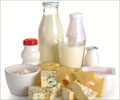In a surprising discovery, scientists have found that milk makes potentially dangerous bacteria like Staphylococcus resistant to antibiotics used for treating animals.
In a surprising discovery, scientists have found that milk makes potentially dangerous bacteria like Staphylococcus resistant to antibiotics used for treating animals.
It is known that many times, bacteria create structures called biofilms to protect them against antibiotics and the body's natural defences.However, scientists have now found that Staphylococcus, which causes mastitis in cows and sheep, can form such protective biofilms to destroy the animal's defences and veterinary medicines.
Mastitis is an infection of the udder in cattle and sheep. It is often a painful condition for the cows, and can even cause death.
"Mastitis is a difficult disease to control. It causes risks for public health if people drink infected milk and is expensive for farmers as it usually causes severe milk production losses, increased treatment costs and means the animals may have to be culled," said Dr Manuela Oliveira from the Faculty of Veterinary Medicine at the Technical University of Lisbon, Portugal.
She added: "When the staphylococci produce a biofilm, the structure protects them against host defences and antibiotic treatment, allowing the bacteria to persist in the udder."
Earlier studied were conducted in laboratories, and thus missed important contributory factors. But in this study, the researchers used realistic conditions found in living animals to overcome this problem.
Advertisement
Now, the researchers are trying to find the correct antibiotic concentrations needed to stop biofilms forming in the first place, and also the concentrations needed to destroy a biofilm that has already formed.
Advertisement
"This will allow for a better control of staphylococcal mastitis, cut disease costs and give an important improvement in the protection of consumers' health," said Oliveira.
She added: "If we can get the doses right, and the animals are cured quicker, we will have less antibiotic residue in the environment and the risk of bacteria such as Staphylococcus aureus developing and spreading antibiotic resistance is lower."
The study was presented at the Society for General Microbiology's Autumn meeting being held this week at Trinity College, Dublin.
Source-ANI
LIN















